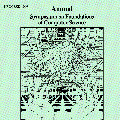Brooks' theorem states that all connected graphs but odd cycles and cliques can be colored with $\Delta$ colors, where $\Delta$ is the maximum degree of the graph. Such colorings have been shown to admit non-trivial distributed algorithms [Panconesi and Srinivasan, Combinatorica 1995] and have been studied intensively in the distributed literature. In particular, it is known that any deterministic algorithm computing a $\Delta$-coloring requires $\Omega(\log n)$ rounds in the LOCAL model [Chang, Kopelowitz, and Pettie, FOCS 2016], and that this lower bound holds already on constant-degree graphs. In contrast, the best upper bound in this setting is given by an $O(\log^2 n)$-round deterministic algorithm that can be inferred already from the works of [Awerbuch, Goldberg, Luby, and Plotkin, FOCS 1989] and [Panconesi and Srinivasan, Combinatorica 1995] roughly three decades ago, raising the fundamental question about the true complexity of $\Delta$-coloring in the constant-degree setting. We answer this long-standing question almost completely by providing an almost-optimal deterministic $O(\log n \log^* n)$-round algorithm for $\Delta$-coloring, matching the lower bound up to a $\log^* n$-factor. Similarly, in the randomized LOCAL model, we provide an $O(\log \log n \log^* n)$-round algorithm, improving over the state-of-the-art upper bound of $O(\log^2 \log n)$ [Ghaffari, Hirvonen, Kuhn, and Maus, Distributed Computing 2021] and almost matching the $\Omega(\log \log n)$-round lower bound by [BFHKLRSU, STOC 2016]. Our results make progress on several important open problems and conjectures. One key ingredient for obtaining our results is the introduction of ruling subgraph families as a novel tool for breaking symmetry between substructures of a graph, which we expect to be of independent interest.
翻译:暂无翻译





